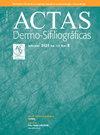EBV相关皮肤淋巴组织增生性疾病的最新进展:系统综述。
IF 3.8
Q1 DERMATOLOGY
引用次数: 0
摘要
皮肤受累的爱泼斯坦-巴氏病毒(EBV)阳性B淋巴增生性疾病(LPD)包括一系列罕见的实体,从不育过程到侵袭性淋巴瘤。自2018年WHO-EORTC对皮肤淋巴瘤进行最新分类以来,血液恶性肿瘤的新分类已发生了重大变化。B 细胞 EBV+ LPD 主要影响免疫力低下的患者,而 T 细胞 EBV+ LPD 在亚洲、中美洲和南美洲等特定地理区域更为流行。本系统综述总结了B细胞和T细胞EBV+ LPD的主要临床、组织学、免疫表型和分子特征,这些特征可能会在诊断时损害皮肤。B 细胞 EBV+ LPD 包括 EBV-MCU 等原发性皮肤淋巴瘤,以及可能出现的皮肤系统淋巴瘤,如淋巴瘤样肉芽肿病(LG)、EBV+ 弥漫性大 B 细胞淋巴瘤、NOS、浆液性淋巴瘤(PBL)和腔外原发性渗出淋巴瘤(EC-PEL)。EBV+、EBV 阳性多形性 B 细胞 LPD 或移植后淋巴组织增生性疾病(PTLD)。关于T细胞EBV+淋巴细胞增生性疾病,这些实体大多归类于T/NK细胞淋巴细胞增生过程和儿童淋巴瘤,包括结节外T/NK淋巴瘤,甚至更特殊的形式,如EBV阳性T细胞中心滤泡淋巴瘤和血管内T/NK细胞淋巴瘤。诊断需要综合本文讨论的临床、组织学、免疫组化和遗传学标准。治疗是多学科的,这给参与这些患者治疗的皮肤科和血液科医生带来了挑战。掌握这一领域的科学证据至关重要,因为必须谨慎避免过度治疗。本文章由计算机程序翻译,如有差异,请以英文原文为准。

Actualización en procesos linfoproliferativos cutáneos relacionados con el virus de Epstein Barr: revisión sistemática
Epstein Barr virus (EBV) positive B lymphoproliferative disorders (LPD) with cutaneous involvement include a series of rare entities that go from indolent processes to aggressive lymphomas. B-cell EBV+ LPD mainly affect immunocompromised patients while T-cell EBV+ LPD are more prevalent in specific geographic regions such as Asia, Central America, and South America. Since the latest WHO-EORTC classification of cutaneous lymphomas in 2018, significant changes have been included in the new classifications of hematological malignancies. This systematic review summarizes the main clinical, histological, immunophenotypic and molecular characteristics of B- and T-cell EBV+ LPD that may compromise the skin at diagnosis. B-cell EBV+ LPD include primary cutaneous lymphomas such as EBV-Mucocutaneous Ulcer, as well as systemic lymphomas affecting the skin at diagnosis that may present such as lymphomatoid granulomatosis (LG), EBV diffuse large B cell lymphoma, NOS, plasmablastic lymphoma (PBL), Extracavitary primary effusion lymphoma (EC-PEL) EBV+, EBV-positive polymorphic B cell LPD, and post-transplant lymphoproliferative disorders (PTLD). Regarding T-cell EBV+ LPD, most of these entities are categorized within T/NK-cell lymphoproliferative processes and lymphomas of childhood, including extranodal T/NK lymphoma, and even more exceptional forms such as EBV-positive T-cell centrofollicular lymphoma and intravascular T/NK-cell lymphoma. Diagnosis is based on integrating the clinical, histological, immunohistochemical, and genetic criteria discussed throughout this article. Differential diagnosis is a challenge for dermatologists and pathologists, so having scientific evidence available in this field is of paramount importance because overtreatment must be carefully avoided.
求助全文
通过发布文献求助,成功后即可免费获取论文全文。
去求助
来源期刊

Actas dermo-sifiliograficas
DERMATOLOGY-
CiteScore
1.90
自引率
9.40%
发文量
473
审稿时长
56 weeks
期刊介绍:
Actas Dermo-Sifiliográficas, publicación Oficial de la Academia Española de Dermatología y Venereología, es una revista de prestigio consolidado. Creada en 1909, es la revista mensual más antigua editada en España.En 2006 entró en Medline, y hoy resulta imprescindible para estar al día sobre la dermatología española y mundial.
 求助内容:
求助内容: 应助结果提醒方式:
应助结果提醒方式:


